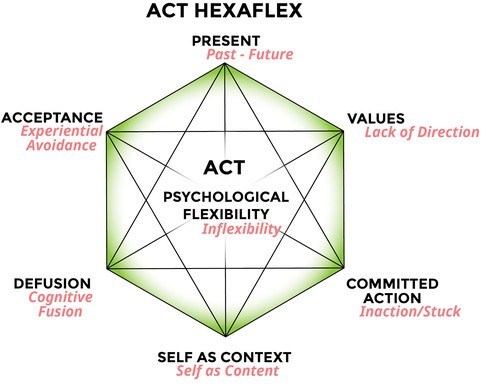We can use ACT? A psychological therapy?? But that’s stepping outside my professional boundary, I couldn’t possibly…
Ok, back up! I can’t speak for Occupational Therapists (OTs) but Physiotherapists (PTs), really?? Are you honestly saying you’re crossing a line? Let’s take a wee trip down my memory lane shall we. On my journey with PT I have found that Physio has nudged itself into osteopathic manipulations, acupuncture, medication prescription, injection therapy, vocational rehab, diagnostic imaging, am I missing anything?
So edging our way into psychological therapies shouldn’t really surprise us. Funny how blurred our “professional boundaries” actually are. Interestingly, the fact that our professional boundaries are so blurred would mean that we have to be adaptable. Even more important is that we are dealing with people and so we should be embracing a blurring of our boundaries.
Right, now that I’ve got that off my chest, I’ll step off my soap box and get back to what I had originally intended to blog about.
Yes, we are perfectly placed to use ACT and yup, you guessed it, I’m going to tell you why I think that’s the case.
Let’s start by explaining Acceptance and Commitment Therapy (ACT) and specifically within the context of persistent pain. Acceptance and Commitment Therapy lies within the Cognitive Behavioural Therapy (CBT) family (McCracken & Vowles, 2014).As CBT, ACT shares an emphasis on cognitive processes and emotional experiences. It varies from CBT in that it emphasizes the necessity of acceptance in order to improve function. ACT is based on the relational frame theory* and focusses on psychological flexibility as the ultimate goal of treatment.
Psychological flexibility refers to the capacity to change or maintain one’s behavior in open contact with thoughts and feelings and, with attention to the opportunities of the current situation in order to realize valued life goals. In the context of chronic pain, psychological flexibility means that painful sensations, feelings, and thoughts are accepted, that attention is focused on the opportunities of the current situations rather than on ruminating about the lost past or catastrophizing about the future, and that behavior is focused on realizing valued goals instead of pain control (Polk, Schoendorff, Webster, & Olaz, 2016).
Another component of ACT is the concept of ‘functional contextualism.’ The fact that it has ‘functional’ within it’s name should just fill OTs and PTs with joy and happy thoughts. Functional contextualism is a pragmatic point of view, pragmatic essentially means practical, the act of doing, yes more words that should fill OTs and PTs hearts with lots of gooey happy feelings and reassurance that its ok to use ACT. On a side note, OTs and PTs philosophy is based within movement, getting people going again, engaging with activity following injury, so yes we are perfectly placed!
Functional contextualism is about finding useful ways to help people learn what works to increase valued living in diverse situations and life circumstances. So, what this means is that people try to find things that work for them in the context of their lives. It’s not about right or wrong, such as in the face of pain “I shouldn’t do this because I will do more damage because that’s what the pain is telling me”, ACT is simply and pragmatically ‘making room’ to enhance valued living.
In addition, functional contextualism is non-judgemental. So, it’s not about categorical thinking as in what’s good or bad because the more you categorize a context the more inflexible things become.
What makes ACT all the more exciting for OTs and PTs is that it aligns so beautifully with so many aspects of pain management approaches that are likely already being used, this might be pacing or graded activity and graded exposure.
Of course, the use of ACT should be delivered through a wider MDT, don’t go all rogue and maverick on me because I gave you permission to use ACT. We are dealing with people and they come with thoughts, feelings and behaviours in all different shapes and sizes, therefore it is important to recognise that when working with people living with pain, this should always be done within the space of an MDT.
There are many great texts out there that you can access to help you understand the theory behind ACT, but in the famous words of Bill Fordyce “For behavior change information is like wet noodles to a brick” meaning that some of the information might stick but not for long and in the face of pain, people will often resort back to living where pain dominates and dictates what they do. So OTs and PTs are familiar with the biology and impairments and physiology to support and work with people when looking to increase their tolerances towards workability and psychological flexibility.
Here’s a lift of texts that I would recommend
- The Happiness Trap – Russ Harris
- ACT made simple – Russ Harris
- The ACT matrix – Kevin Polk
My advice for OTs and PTs would be to really explore using ACT in your day to day work. There is a huge network of clinicians on social media that can direct you to the right place if you want to upskill in this area.
Thanks for having a read
TNP
References
McCracken, L., & Vowles, K. (2014). Acceptance and Commitment Therapy andMindfulness for Chronic Pain. American Psychologist , 69(2), 178–187.
Polk, K., Schoendorff, B., Webster, M., & Olaz, F. O. (2016). The Essential Guide to the ACT Matrix. Oakland, CA: Harbinger Publications, Inc.


Leave a comment